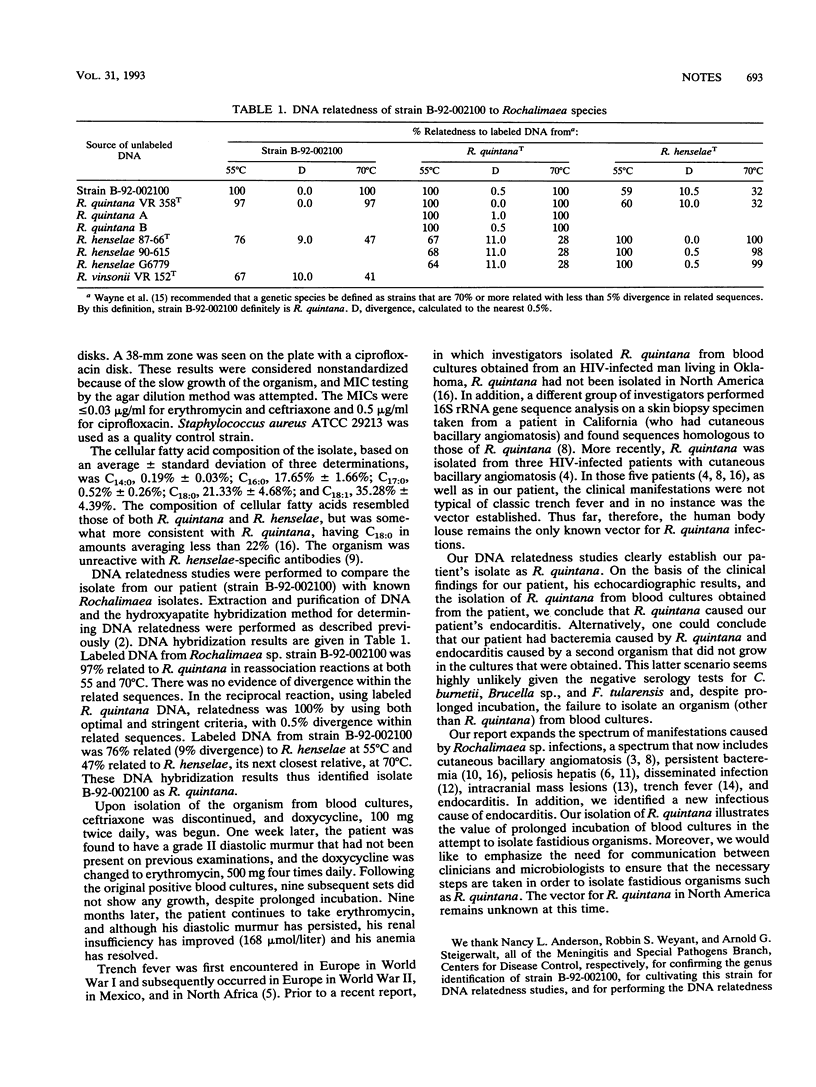Abstract
Rochalimaea quintana and Rochalimaea henselae are closely related, fastidious, gram-negative rickettsiae. Thus far, the spectrum of human Rochalimaea sp. infections has not included endocarditis. We describe a 50-year-old human immunodeficiency virus-positive man who developed endocarditis caused by R. quintana. DNA relatedness studies, which compared our patient's blood culture isolate with known Rochalimaea species, identified the organism as R. quintana. Our report expands the spectrum of Rochalimaea sp. infections and identifies a new infectious cause of endocarditis.
Full text
PDF


Selected References
These references are in PubMed. This may not be the complete list of references from this article.
- Bauer A. W., Kirby W. M., Sherris J. C., Turck M. Antibiotic susceptibility testing by a standardized single disk method. Am J Clin Pathol. 1966 Apr;45(4):493–496. [PubMed] [Google Scholar]
- Brenner D. J., McWhorter A. C., Knutson J. K., Steigerwalt A. G. Escherichia vulneris: a new species of Enterobacteriaceae associated with human wounds. J Clin Microbiol. 1982 Jun;15(6):1133–1140. doi: 10.1128/jcm.15.6.1133-1140.1982. [DOI] [PMC free article] [PubMed] [Google Scholar]
- Cockerell C. J., LeBoit P. E. Bacillary angiomatosis: a newly characterized, pseudoneoplastic, infectious, cutaneous vascular disorder. J Am Acad Dermatol. 1990 Mar;22(3):501–512. doi: 10.1016/0190-9622(90)70071-o. [DOI] [PubMed] [Google Scholar]
- Koehler J. E., Quinn F. D., Berger T. G., LeBoit P. E., Tappero J. W. Isolation of Rochalimaea species from cutaneous and osseous lesions of bacillary angiomatosis. N Engl J Med. 1992 Dec 3;327(23):1625–1631. doi: 10.1056/NEJM199212033272303. [DOI] [PubMed] [Google Scholar]
- Myers W. F., Grossman D. M., Wisseman C. L., Jr Antibiotic susceptibility patterns in Rochalimaea quintana, the agent of trench fever. Antimicrob Agents Chemother. 1984 Jun;25(6):690–693. doi: 10.1128/aac.25.6.690. [DOI] [PMC free article] [PubMed] [Google Scholar]
- Perkocha L. A., Geaghan S. M., Yen T. S., Nishimura S. L., Chan S. P., Garcia-Kennedy R., Honda G., Stoloff A. C., Klein H. Z., Goldman R. L. Clinical and pathological features of bacillary peliosis hepatis in association with human immunodeficiency virus infection. N Engl J Med. 1990 Dec 6;323(23):1581–1586. doi: 10.1056/NEJM199012063232302. [DOI] [PubMed] [Google Scholar]
- Regnery R. L., Anderson B. E., Clarridge J. E., 3rd, Rodriguez-Barradas M. C., Jones D. C., Carr J. H. Characterization of a novel Rochalimaea species, R. henselae sp. nov., isolated from blood of a febrile, human immunodeficiency virus-positive patient. J Clin Microbiol. 1992 Feb;30(2):265–274. doi: 10.1128/jcm.30.2.265-274.1992. [DOI] [PMC free article] [PubMed] [Google Scholar]
- Relman D. A., Loutit J. S., Schmidt T. M., Falkow S., Tompkins L. S. The agent of bacillary angiomatosis. An approach to the identification of uncultured pathogens. N Engl J Med. 1990 Dec 6;323(23):1573–1580. doi: 10.1056/NEJM199012063232301. [DOI] [PubMed] [Google Scholar]
- Slater L. N., Coody D. W., Woolridge L. K., Welch D. F. Murine antibody responses distinguish Rochalimaea henselae from Rochalimaea quintana. J Clin Microbiol. 1992 Jul;30(7):1722–1727. doi: 10.1128/jcm.30.7.1722-1727.1992. [DOI] [PMC free article] [PubMed] [Google Scholar]
- Slater L. N., Welch D. F., Hensel D., Coody D. W. A newly recognized fastidious gram-negative pathogen as a cause of fever and bacteremia. N Engl J Med. 1990 Dec 6;323(23):1587–1593. doi: 10.1056/NEJM199012063232303. [DOI] [PubMed] [Google Scholar]
- Slater L. N., Welch D. F., Min K. W. Rochalimaea henselae causes bacillary angiomatosis and peliosis hepatis. Arch Intern Med. 1992 Mar;152(3):602–606. [PubMed] [Google Scholar]
- Spach D. H. Bacillary angiomatosis. Int J Dermatol. 1992 Jan;31(1):19–24. doi: 10.1111/j.1365-4362.1992.tb03512.x. [DOI] [PubMed] [Google Scholar]
- Spach D. H., Panther L. A., Thorning D. R., Dunn J. E., Plorde J. J., Miller R. A. Intracerebral bacillary angiomatosis in a patient infected with human immunodeficiency virus. Ann Intern Med. 1992 May 1;116(9):740–742. doi: 10.7326/0003-4819-116-9-740. [DOI] [PubMed] [Google Scholar]
- Vinson J. W., Varela G., Molina-Pasquel C. Trench fever. 3. Induction of clinical disease in volunteers inoculated with Rickettsia quintana propagated on blood agar. Am J Trop Med Hyg. 1969 Sep;18(5):713–722. [PubMed] [Google Scholar]
- Welch D. F., Pickett D. A., Slater L. N., Steigerwalt A. G., Brenner D. J. Rochalimaea henselae sp. nov., a cause of septicemia, bacillary angiomatosis, and parenchymal bacillary peliosis. J Clin Microbiol. 1992 Feb;30(2):275–280. doi: 10.1128/jcm.30.2.275-280.1992. [DOI] [PMC free article] [PubMed] [Google Scholar]


